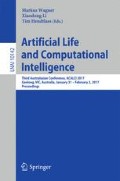Abstract
We use an adversarial approach inspired by biological coevolution to generate complex line drawings without human guidance. Artificial artists and critics work against each other in an iterative competitive framework, forcing each to become increasingly sophisticated to outplay the other. Both the artists and critics are implemented in hercl, a framework combining linear and stack-based Genetic Programming, which is well suited to coevolution because the number of competing agents is kept small while still preserving diversity. The aesthetic quality of the resulting images arises from the ability of the evolved hercl programs, making judicious use of register adjustments and loops, to produce repeated substructures with subtle variations, in the spirit of low-complexity art.
Access this chapter
Tax calculation will be finalised at checkout
Purchases are for personal use only
References
Axelrod, R.: The Evolution of Cooperation. Basic Books, New York (1984)
Blair, A.: Learning the Caesar and Vigenere Cipher by hierarchical evolutionary re-combination. In: Congress on Evolutionary Computation, pp. 605–612 (2013)
Blair, A.D.: Transgenic evolution for classification tasks with HERCL. In: Chalup, S.K., Blair, A.D., Randall, M. (eds.) ACALCI 2015. LNCS (LNAI), vol. 8955, pp. 185–195. Springer, Heidelberg (2015). doi:10.1007/978-3-319-14803-8_15
Colton, C.: Stroke matching for paint dances. In: International Symposium on Computational Aesthetics in Graphics, Visualization and Imaging (2010)
Datta, R., Joshi, D., Li, J., Wang, J.Z.: Studying aesthetics in photographics images using a computational approach. In: Proceedings of European Conference on Computer Vision, pp. 288–301 (2006)
Galanter, P.: Computational aesthetic evaluation: past and future. In: McCormack, J., d’Inverno, M. (eds.) Computers and Creativity, pp. 255–293. Springer, Berlin (2012)
Goodfellow, I., Pouget-Abadie, J., Mirza, M., Xu, B., Warde-Farley, D., Ozair, S., Courville, A., Bengio, Y.: Generative adversarial nets. In: Advances in Neural Information Processing Systems, pp. 2672–2680 (2014)
Kowaliw, T., Dorin, A., McCormack, J.: Promoting creative design in interactive evolutionary computation. IEEE Trans. Evol. Comput. 16(4), 523 (2012)
Li, Y., Hu, C.-J.: Aesthetic learning in an interactive evolutionary art system. In: Chio, C., et al. (eds.) EvoApplications 2010. LNCS, vol. 6025, pp. 301–310. Springer, Heidelberg (2010). doi:10.1007/978-3-642-12242-2_31
Machado, P., Romero, J., Manaris, B.: Experiments in computational aesthetics: an iterative approach to stylistic change in evolutionary art. In: Romero, J., Machado, P. (eds.) The Art of Artificial Evolution, pp. 381–415. Springer, Berlin (2008)
Saunders, R., Gero, J.S.: Artificial creativity: a synthetic approach to the study of creative behaviour. Comput. Cogn. Models Creat. Des. V, 113–139 (2001). Key Centre of Design Computing and Cognition. University of Sydney, Sydney
Schmidhuber, J.: Low-complexity art. Leonardo, J. Int. Soc. Arts Sci. Technol. 30(2), 97–103 (1997)
Secretan, J., Beato, N., D’Ambrosio, D.B., Rodriguez, A., Campbell, A., Folsom-Kovarik, J.T., Stanley, K.O.: Picbreeder: a case study in collaborative evolutionary exploration of design space. Evol. Comput. 19(3), 373–403 (2011)
Author information
Authors and Affiliations
Corresponding author
Editor information
Editors and Affiliations
Rights and permissions
Copyright information
© 2017 Springer International Publishing AG
About this paper
Cite this paper
Vickers, D., Soderlund, J., Blair, A. (2017). Co-Evolving Line Drawings with Hierarchical Evolution. In: Wagner, M., Li, X., Hendtlass, T. (eds) Artificial Life and Computational Intelligence. ACALCI 2017. Lecture Notes in Computer Science(), vol 10142. Springer, Cham. https://doi.org/10.1007/978-3-319-51691-2_4
Download citation
DOI: https://doi.org/10.1007/978-3-319-51691-2_4
Published:
Publisher Name: Springer, Cham
Print ISBN: 978-3-319-51690-5
Online ISBN: 978-3-319-51691-2
eBook Packages: Computer ScienceComputer Science (R0)

